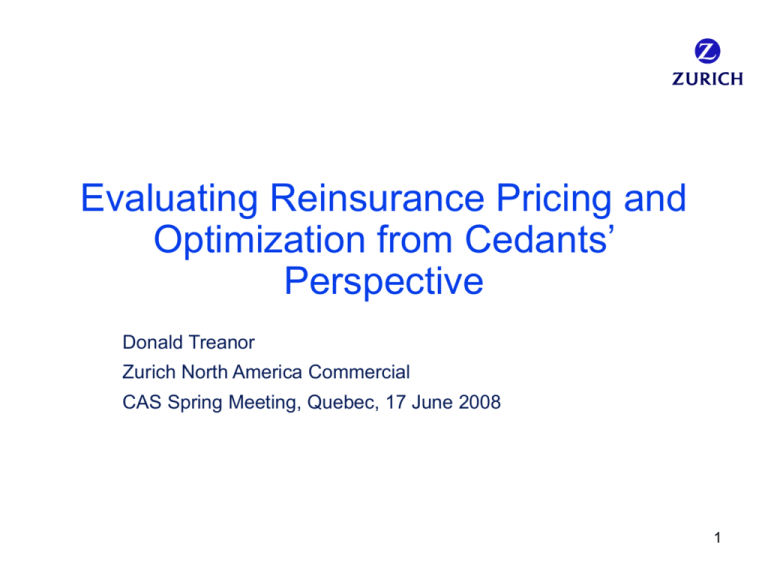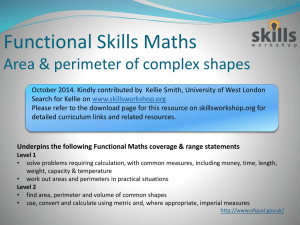Evaluating Reinsurance Pricing and Optimization from Cedants
advertisement

Evaluating Reinsurance Pricing and Optimization from Cedants’ Perspective Donald Treanor Zurich North America Commercial CAS Spring Meeting, Quebec, 17 June 2008 1 Disclaimer • The opinions expressed in this presentation are those of the presenter and are not the opinions of the CAS or the presenter’s employer 2 Agenda • Why Optimize Reinsurance • Initial Steps – Risk Tolerance – Minimum Attachment – Maximum Retention • • • • Overview of Sample Company XYZ Reinsurance Options Metrics Conclusion 3 Why Buy Reinsurance According to “Hoyle” • Stability • Catastrophe protection • Capacity • Surplus relief • Underwriting expertise • Withdrawal from a territory or line of business 4 Why We Really Buy Reinsurance • I don’t want those losses to affect my bonus. • Not sure we should be writing this stuff to begin with, let’s get rid of it. • Because that’s what we did last year. 5 Initial Steps in Optimization • Evaluate Risk Tolerance – Depends on surplus – Depends on desired rating – Depends on diversification – Depends on profitability/cycle – Done at high level – Over all business units/legal entities – Preferably multiple years 6 Initial Steps in Optimization • Set Minimum Attachment – Set at overall business level – Can be set by line – Should consider dollar trading – Should consider standard deviation of losses 7 Initial Steps in Optimization • Setting Maximum Retention – Best’s Capital Adequacy Ratio requirement – Other regulatory requirements – Percentage of surplus – Maximum Tail Value at Risk (TVaR) – Percentile Losses 8 XYZ Insurance Company • Four Business Divisions Total Subject Premium 2,025M – Four Major Lines of Business in Each – Line 3 is Natural Catastrophe Exposed Business Unit 1 Business Unit 2 Business Unit 3 Business Unit 4 Total Line 1 90,000,000 135,000,000 90,000,000 162,000,000 477,000,000 Subject Premium Line 2 Line 3 27,000,000 162,000,000 45,000,000 243,000,000 18,000,000 45,000,000 171,000,000 270,000,000 261,000,000 720,000,000 Line 4 243,000,000 162,000,000 27,000,000 135,000,000 567,000,000 Total 522,000,000 585,000,000 180,000,000 738,000,000 2,025,000,000 9 XYZ Insurance Company • Minimum Retention 50M • Cat Protection 500M xs 100M • 6 different options, based on retentions, deductibles and reinstatements 10 Simulation Model • Losses are Modeled in Three Pieces – Attritional losses are modeled based on expected loss ratio and do not impact the reinsurance retention layers – Large losses are modeled based on frequency and severity distributions and have the potential to impact the reinsurance retention layers – Catastrophe losses are modeled based on the Beta distribution with secondary uncertainty similar to standard catastrophe models • Large losses are applied to the reinsurance options based on 100,000 simulations and representative metrics are collected 11 Reinsurance Structures 50M xs 50M Reinstatements 2@100 50M xs 50M Reinstatements 1@100 50M Annual Aggregate Deductible Retained Layer Line 1 Line 2 Line 3 Option 1 50M xs 50M Reinstatements 2@100 65M xs 10M Reinstatements 2@100 25M AAD Retained Layer Line 4 Line 1 Line 2 Line 3 Option 2 50M AAD Retained Layer Line 4 Retained Layer Line 1 Line 2 Line 4 Option 3 Line 1 Line 2 Line 4 Option 4 12 Reinsurance Structures 50M xs 50M 50M xs 50M 50M xs 50M 50M xs 50M 50M xs 50M 50M xs 50M 50M xs 50M 1@100 1@100 1@100 1@100 1@100 1@100 1@100 40M xs 10M 1@100 Retained Layer Line 1 Line 2 Option 5 Line 3 Line 4 Line 1 Line 2 Line 3 Line 4 Option 6 13 XYZ Insurance Company Excess Layer Optimization Based on 100,000 Simulations w/o RI Option1 Option2 Option3 Option4 Option5 Option6 Premium figures in million USD Calculated metrics R I Net UW Result LR [1] Gross [2] Ceded [3] Net [4] Gross (w/o RI); Ceded [5] Expected UW Result [6] Standard Deviation [7] Return Period for UW Result < 0 [8] 1 in 5y [9] 1 in 10y [10] 1 in 50y [11] 1 in 100y [12] 1 in 250y [13] Tvar([7]) (Expected UW Result if UW Result < 0) [14] Cost of Reinsurance (Ceded (Losses-Premium)) [16] CV (standard deviation / expected. [6]/[5]) [17] Reduction in UW Result [18] Reduction in Volatility [19] Reduction in Volatility / Reduction in UW Result ([18]/[17]) [20] Change in TVar / Cost of Reinsurance (-D[13]/[14]) [21] Expected Insurer's Deficit (-[13]/[3]/[7]) 2,025.0 2,025.0 0.0 149.8 2,025.0 1,875.2 67.4% 68.5% 75.0 5.4 272.1 206.1 1 in 3.2 years 1 in 2.2 years -99.6 -148.8 -254.9 -250.4 -651.9 -474.6 -853.3 -590.9 -1,135.0 -790.0 -232.1 -169.9 n/a -69.6 3.63 38.32 n/a 93%; -69.6 n/a 24%; -66 n/a 0.95 n/a 0.89 3.6% 4.1% 2,025.0 118.9 1,906.1 68.4% 15.8 208.0 1 in 2.3 years -140.4 -242.6 -467.5 -582.3 -781.2 -169.1 -59.2 13.17 79%; -59.2 24%; -64.1 1.08 1.06 3.8% 2,025.0 229.9 1,795.1 68.5% -20.3 203.5 1 in 2 years -171.6 -272.0 -495.4 -606.8 -808.8 -174.1 -95.3 -10.03 127%; -95.3 25%; -68.7 0.72 0.61 4.9% 2,025.0 118.3 1,906.7 68.4% 16.1 208.2 1 in 2.3 years -140.2 -242.6 -467.2 -583.6 -778.0 -163.7 -58.9 12.97 79%; -58.9 23%; -63.9 1.09 1.16 3.7% 2,025.0 151.9 1,873.1 68.6% 3.3 203.8 1 in 2.2 years -148.4 -249.0 -472.9 -585.4 -784.1 -152.8 -71.7 62.68 96%; -71.7 25%; -68.3 0.95 1.11 3.7% 2,025.0 173.3 1,851.7 68.6% -4.3 202.7 1 in 2.1 years -155.1 -255.2 -479.4 -592.9 -790.2 -165.0 -79.3 -47.23 106%; -79.3 26%; -69.4 0.88 0.85 4.2% 14 XYZ Insurance Company Excess Layer Optimization Based on 100,000 Simulations UW Result for specific Return Periods (downside) 1 in 250y 1 in 100y 1 in 50y Option6 Option5 Option4 Option3 Option2 Option1 w /o RI 1 in 10y 1 in 5y -50 150 350 550 UW Result (-M$) 750 950 1,150 1,350 15 XYZ Insurance Company Excess Layer Optimization Based on 100,000 Simulations 100% 80% 60% 40% 20% pt io n6 O pt io n5 O pt io n4 O pt io n3 O O pt io n2 0% pt io n1 • Higher is better 120% O • How much volatility is reduced for each dollar of underwriting income sacrificed Reduction in Volatility / Reduction in UW Result 16 XYZ Insurance Company Excess Layer Optimization Based on 100,000 Simulations • How much TVaR is reduced for each dollar spent on Reinsurance – Cost of Reinsurance includes premium and expected recoveries • Higher is better Change in TVar / Cost of Reinsurance 120% 100% 80% 60% 40% 20% 0% Option1 Option2 Option3 Option4 Option5 Option6 17 XYZ Insurance Company Excess Layer Optimization Based on 100,000 Simulations 6.0% 5.0% 4.0% 3.0% 2.0% 1.0% pt io n6 O pt io n5 O pt io n4 O pt io n3 O pt io n2 O pt io n1 O R I 0.0% /o • Lower is better. Expected Insurer's Deficit w • Average underwriting loss if underwriting income is negative times the probability of being negative divided by net subject premium 18 XYZ Insurance Company Excess Layer Optimization Based on 100,000 Simulations 20,000,000 Option1 Expected Net Underwriting Result 15,000,000 10,000,000 Option2 5,000,000 Option3 0 -5,000,000 Option4 -10,000,000 -15,000,000 Option5 -20,000,000 -25,000,000 202,000,000 Option6 203,000,000 204,000,000 (1) Return = Mean Risk = Standard Deviation Gross 74,979,609 272,130,823 (1) Gross Risk - Option Risk (2) Gross Return - Option Return (3) Risk/Return Trade-off Ratio = (1)/(2) 205,000,000 206,000,000 207,000,000 Standard Deviation of Net Underwriting Result (2) (3) (4) 208,000,000 (5) 209,000,000 (6) (7) Option1 5,378,489 206,084,708 Option2 15,799,400 208,031,109 Option3 -20,288,219 203,466,011 Option4 16,053,221 208,192,026 Option5 3,251,325 203,807,418 Option6 -4,291,907 202,692,845 66,046,115 69,601,121 94.9% 64,099,714 59,180,209 108.3% 68,664,812 95,267,828 72.1% 63,938,797 58,926,388 108.5% 68,323,405 71,728,285 95.3% 69,437,978 79,271,516 87.6% 19 Conclusions • Reinsurance purchases can be optimized • Part of a consistent strategy • Retentions based on position of the overall firm • Metrics based on strategic direction of the firm • Watch what metrics measure • Tool for decision making, not substitute 20






